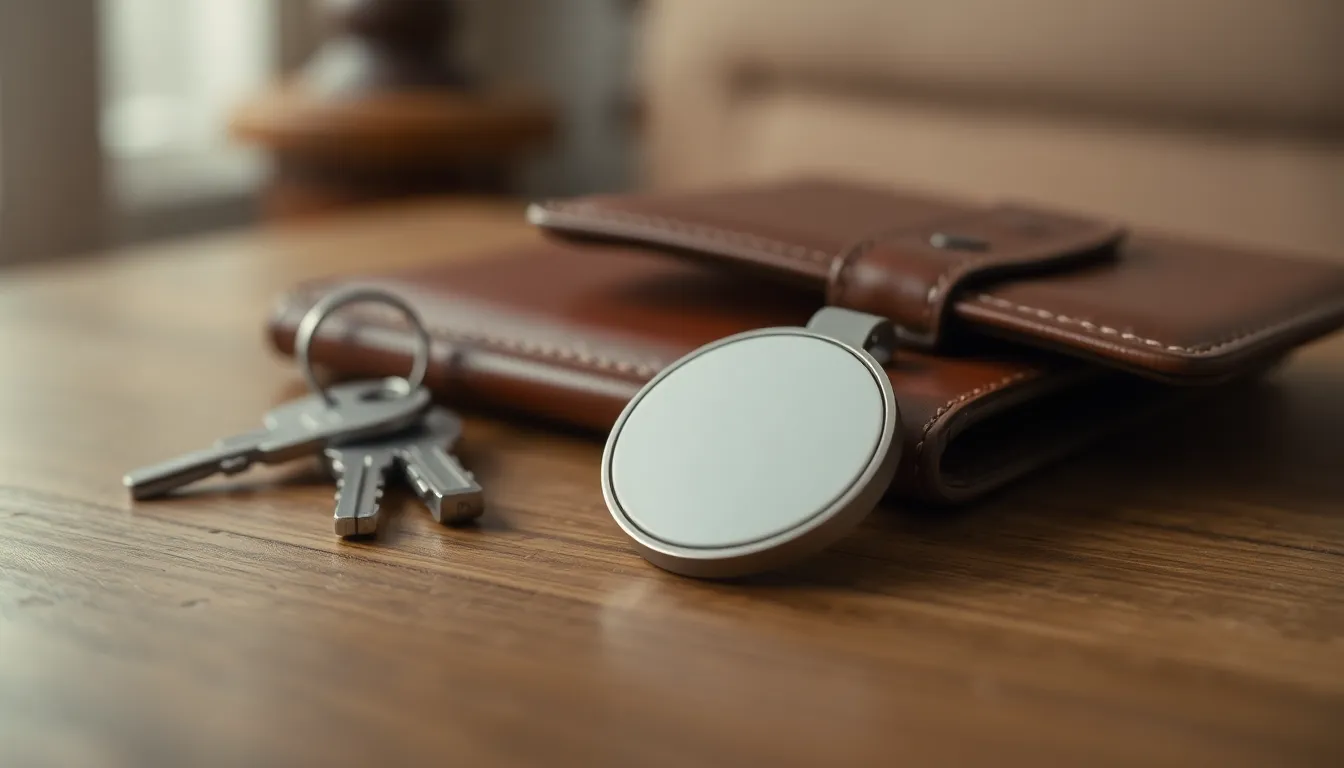Table of Contents
ToggleImagine losing your keys for the umpteenth time and realizing your AirTag is just a tiny superhero waiting to save the day. But how long can this little gadget keep up its heroics? Knowing the lifespan of an AirTag isn’t just trivia; it’s essential if you want to avoid a dramatic showdown with your couch cushions.
Overview of AirTag Longevity
AirTags utilize a replaceable CR2032 battery, which generally provides an impressive lifespan of about one year with standard use. Battery life may vary, depending on usage patterns. Frequent tracking or alerts can drain the battery more quickly, affecting overall longevity.
AirTags feature energy-efficient technology, enhancing their duration between battery changes. Notifications will indicate when the battery is running low, allowing users to replace it proactively.
Environmental factors also play a role in the longevity of an AirTag. Extreme temperatures, both hot and cold, can impact battery performance. Humidity levels can also affect overall functionality, though AirTags are designed to withstand everyday conditions.
Effective tracking often means that users should regularly monitor battery levels. They can check the status through the Find My app, which provides immediate updates on the device’s condition. Ensuring a timely battery replacement prevents disruption in tracking capabilities.
Overall, understanding how usage habits influence battery life empowers users to maximize their AirTag’s performance. Keeping the device in optimal conditions can contribute to a more reliable experience.
Battery Life of AirTag

AirTags utilize a replaceable CR2032 battery, providing users with effective tracking capabilities for around one year under standard conditions. This duration can fluctuate based on specific usage patterns and environmental factors.
Expected Battery Duration
Users can typically expect their AirTag battery to last up to 12 months. Regular usage, including occasional tracking and notifications, influences this lifespan. As tracking frequency increases, the battery drains faster. Checking the battery status within the Find My app helps users know when replacements are necessary. Notifications regarding low battery conditions prompt timely replacements, ensuring that tracking remains uninterrupted.
Factors Affecting Battery Life
Several factors impact AirTag battery life. Environmental conditions such as temperature and humidity can accelerate battery depletion. Increased usage, such as frequent notifications or continuous tracking, also plays a significant role. Prolonged use of features like Precision Finding drains energy rapidly. Properly monitoring battery levels through the Find My app enables users to adjust their usage accordingly, promoting longer battery endurance.
Usage Scenarios
AirTags serve various purposes based on user needs and circumstances. Understanding these scenarios helps optimize battery life and tracking efficiency.
Everyday Tracking
AirTags excel at helping users locate everyday items like keys, bags, and wallets. They provide reliable tracking through the Find My app, allowing individuals to pinpoint their belongings quickly. For consistent use, the battery typically lasts about one year under normal tracking conditions. Users who frequently check item locations may notice a reduction in battery life. Instead of worrying about battery depletion, individuals can receive low battery notifications, enabling timely replacements. Keeping an eye on usage habits, like the frequency of tracking, supports efficient battery management. Optimizing tracking can lead to longer-lasting performance for everyday items.
Extreme Conditions
Extreme environments can significantly impact AirTag performance. High humidity and temperatures beyond the recommended range affect battery efficiency. Users often place AirTags on outdoor items, like bikes or camping gear, which may expose them to harsh conditions. Constant fluctuations in temperature can cause battery life to decrease more quickly than usual. Nonetheless, AirTags utilize energy-efficient technology to prolong battery lifespan where possible. Users should monitor their battery status regularly through the Find My app, especially after exposure to extreme conditions. Proactive checks ensure optimal functionality and maintenance of tracking capabilities even in challenging environments.
Maintenance Tips for AirTag Longevity
Ensuring the longevity of an AirTag involves simple maintenance practices. Users can follow certain tips to maximize battery life and overall functionality.
Battery Replacement
Replacing the battery in an AirTag takes just a few minutes. The CR2032 battery, found inside, typically lasts around one year under standard usage. Users should watch for notifications indicating low battery levels through the Find My app. When it’s time for a replacement, remove the back cover by twisting it counterclockwise. After replacing the old battery with a new one, align the cover and twist it back into place. This easy maintenance task helps maintain optimal tracking capabilities.
Proper Handling and Care
Proper handling significantly impacts the performance of an AirTag. Keeping the device clean prevents dust and dirt from interfering with its functionality. Users should avoid exposing the AirTag to extreme temperatures and high humidity, as these conditions can accelerate battery drain. Storing the AirTag in a protective case can also shield it from physical damage. Regularly checking the condition of the AirTag allows users to identify and address any issues early. Following these care tips enhances the device’s reliability and ensures effective tracking over time.
Comparison with Other Tracking Devices
AirTags distinguish themselves in battery life among tracking devices. Many alternatives, like Tile, also utilize similar replaceable batteries, but their longevity varies. Tile Pro, for instance, lasts about one year on a CR2032 battery, comparable to AirTags under standard use.
Battery options differ significantly across brands. Some tracking devices might offer rechargeable batteries, which could appeal to users preferring long-term use without regular replacements. However, extended charging can inconvenience users who need immediate tracking solutions.
Trackers needing frequent recharging might not provide the immediate convenience AirTags offer. Competitors like Samsung Galaxy SmartTag rely on replaceable CR2032 batteries too, with a life expectancy similar to that of AirTags. Nonetheless, environmental factors can impact both devices, often resulting in quicker battery drainage.
User engagement affects all tracking devices. Frequent use of location services can considerably shorten battery life, regardless of the brand. Consequently, consistent monitoring of battery levels through available apps proves essential for maintaining functionality.
In terms of environmental resistance, higher durability ratings exist among some competitors, which can withstand harsher conditions better than AirTags. Others, including certain Tile models, incorporate water-resistant features, adding another layer of performance.
While AirTags utilize energy-efficient technology, similar advancements appear in rival products. Users may choose based on specific preferences and priorities, such as battery longevity and usage patterns, impacting their overall tracking experience. Each option provides unique advantages and considerations, assisting users in making informed decisions about their tracking needs.
AirTags provide a reliable solution for tracking lost items with their efficient battery life. Users can expect around 12 months of use under normal conditions. However, habits like frequent tracking can shorten this lifespan. Regularly checking the battery status through the Find My app is essential for maintaining optimal functionality.
By understanding the factors that influence battery performance and taking proactive measures, users can enhance their tracking experience. Whether it’s replacing the battery or protecting the device from extreme conditions, these steps ensure AirTags remain effective tools in everyday life.




